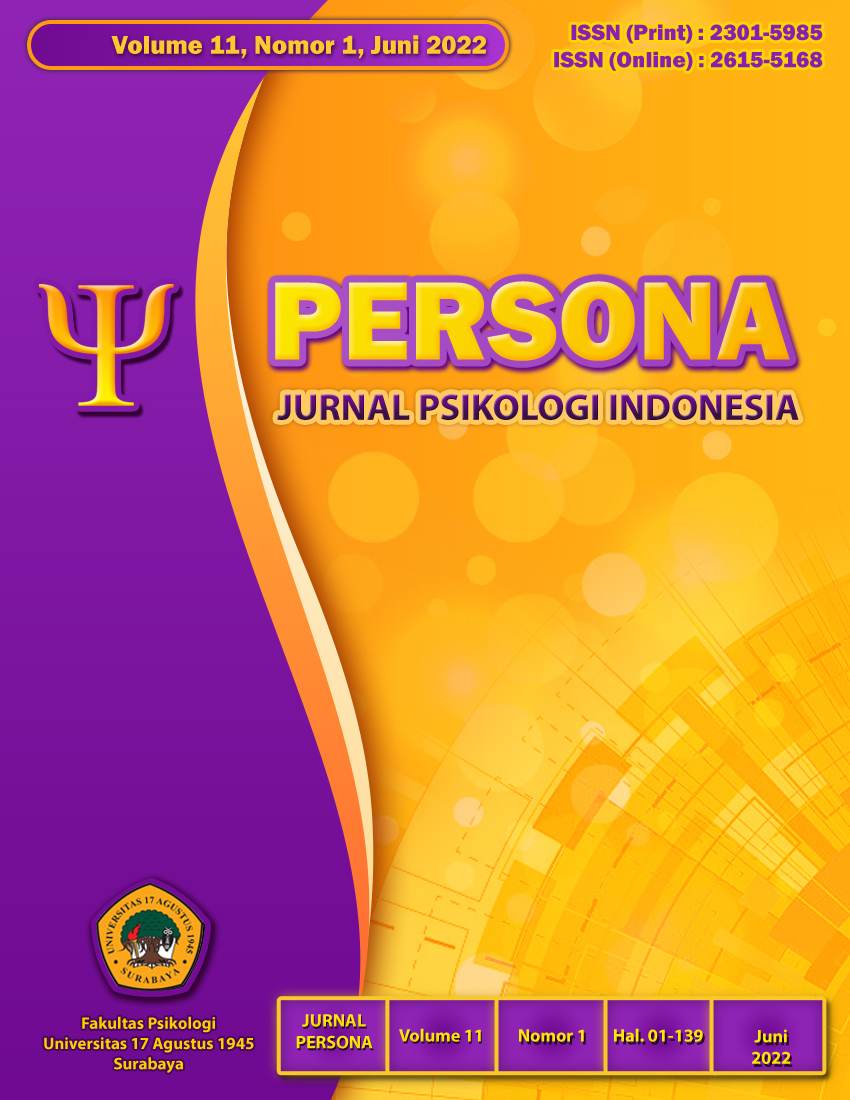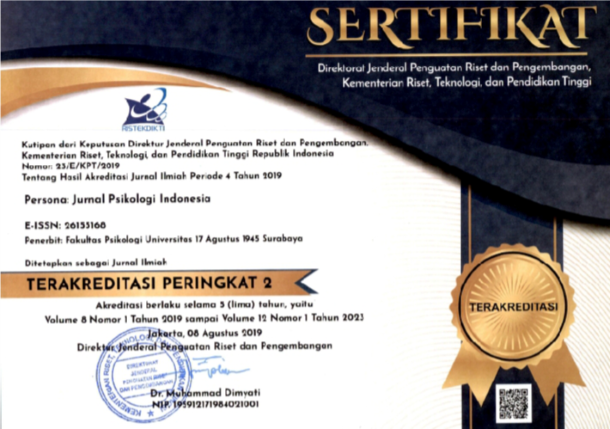Stres warga binaan pemasyarakatan di masa pandemi Covid-19: Menguji peranan dukungan sosial dan orientasi budaya
Abstract
Abstract
This study aims to determine whether there is a simultaneous influence of social support and cultural orientation on the stress level of correctional inmates in Rutan Class II B Salatiga. One hundred thirty-two prisoners participated in the study. This study used a quantitative approach with regression analysis to answer the research objectives. The measuring tools are the Social Support Scale (α=0,912), Cultural Orientation Scale (α=0,722), and DASS-21 (α=0,846). The results showed no significant effect between social support and cultural orientation on the stress level of WBP in Salatiga Rutan. The results of the descriptive analysis showed that most of the participants' stress and social support were moderate, and all participants had a high vertical collectivism cultural orientation. So, the detention center needs to pay attention to the condition of the inmate's stress level and minimize the factors that can affect stress.
Keywords: stress, social support, culture orientation, correctional inmates, COVID-19 pandemic
Abstrak
Penelitian ini bermaksud untuk mengetahui apakah terdapat pengaruh dukungan sosial dan orientasi budaya secara simultan dengan tingkat stres Warga Binaan Pemasyarakatan di Rutan Klas II B Salatiga. Sebanyak 132 orang Warga Binaan Pemasyarakatan menjadi partisipan. Pendekatan kuantitatif dengan analisis regresi berganda untuk menjawab pertanyaan penelitian. Skala pengukuran yang digunakan adalah Social Support Scale (α=0,912), Cultural Orientation Scale (α=0,722), dan DASS-21 (α=0,846). Dari hasil penelitian disimpulkan tidak terdapat pengaruh yang signifikan secara simultan antara dukungan sosial dan orientasi budaya dengan tingkat stres Warga Binaan Pemasyarakatan. Hasil analisis deskriptif menunjukkan bahwa stres maupun dukungan sosial sebagian besar partisipan berada pada tingkat sedang dan seluruh partisipan memiliki orientasi budaya vertical collectivism pada taraf tinggi. Untuk itu pihak Rutan perlu memperhatikan kondisi kesehatan mental Warga Binaan Pemasyarakatan dan meminimalkan faktor-faktor yang dapat mempengaruhinya.
Kata kunci: tingkat stres, dukungan sosial, orientasi budaya, warga binaan pemasyarakatan, pandemi COVID-19
Downloads
References
Antony, M. M., Cox, B. J., Enns, M. W., Bieling, P. J., & Swinson, R. P. (1998). Psychometric properties of the 42-item and 21-item versions of the Depression Anxiety Stress Scales in clinical groups and a community sample. Psychological Assessment, 10(2), 176–181. https://doi.org/10.1037/1040-3590.10.2.176
Ayçiçeği Dinn, A., & Caldwell-Harris, C. L. (2016). How collectivism and family control influence depressive symptoms in Asian American and European American college students. Elektronik Sosyal Bilimler Dergisi, 15(57). https://doi.org/10.17755/esosder.44308
Bailey, F. J., & Dua, J. (1999). Individualism-collectivism, coping styles, and stress in international and Anglo-Australian students: A comparative study. Australian Psychologist, 34(3), 177–182. https://doi.org/10.1080/00050069908257451
Balogun, A. G. (2014). Dispositional factors , perceived social support and happiness among prison inmates in Nigeria : A new look N ijerya ’ daki hapishane mahkumlarında kişilik faktörleri , algıla nan sosyal destek ve. The Journal of Happiness & Well-Being, 2(1), 16–33.
Ben-Ari, A., & Lavee, Y. (2004). Cultural orientation, ethnic affiliation, and negative daily occurrences: A Multidimensional Cross-Cultural Analysis. American Journal of Orthopsychiatry, 74(2), 102–111. https://doi.org/10.1037/0002-9432.74.2.102
Bhullar, N., Schutte, N. S., & Malouff, J. M. (2012). Associations of individualistic-collectivistic orientations with emotional intelligence, mental health, and satisfaction with life: A tale of two countries. Individual Differences Research, 10(3), 165–175.
Caravaca-Sánchez, F., & García-Jarillo, M. (2020). Perceived social support, resilience and consumption of psychoactive substances amongst inmates in prisons. Revista Española de Sanidad Penitenciaria, 22(2), 75–79. https://doi.org/10.18176/resp.00013
Costanzo, L. A. (2004). Strategic foresight in a high-speed environment. Futures, 36(2), 219–235. https://doi.org/10.1016/S0016-3287(03)00145-9
Dirgayunita, A. (2016). Depresi: Ciri, Penyebab dan Penangannya. Journal An-Nafs: Kajian Penelitian Psikologi, 1(1), 1–14. https://doi.org/10.33367/psi.v1i1.235
Fahmi, A. Y. (2019). Hubungan dukungan sosial dengan tingkat stres pada warga binaan pemasyarakatan perempuan di lembaga pemasyarakatan. Holistic Nursing and Health Science, 2(2), 42–47. https://doi.org/10.14710/hnhs.2.2.2019.42-47
Febrianti, M., & Masnina, R. (2019). Hubungan antara dukungan sosial dengan tingkat stress pada narapidana di lapas narkotika kelas III Samarinda. Borneo Student Research, 1(1), 476–481.
Giallonardo, V., Sampogna, G., Del Vecchio, V., Luciano, M., Albert, U., Carmassi, C., Carrà, G., Cirulli, F., Dell’Osso, B., Nanni, M. G., Pompili, M., Sani, G., Tortorella, A., Volpe, U., & Fiorillo, A. (2020). The impact of quarantine and physical distancing following covid-19 on mental health: Study protocol of a multicentric italian population trial. Frontiers in Psychiatry, 11(June), 1–10. https://doi.org/10.3389/fpsyt.2020.00533
Greenberg, J., Solomon, S., & Pyszczynski, T. (1997). Terror management theory of self-esteem and cultural worldviews: empirical assessments and conceptual refinements. Advances in Experimental Social Psychology, 29(C), 61–139. https://doi.org/10.1016/S0065-2601(08)60016-7
Hewson, T., Shepherd, A., Hard, J., & Shaw, J. (2020). Effects of the COVID-19 pandemic on the mental health of prisoners. The Lancet Psychiatry, 7(7), 568–570. https://doi.org/10.1016/S2215-0366(20)30241-8
Hidayat, R. H. (2020). Langkah – langkah strategis untuk mencegah pandemi covid-19 di lembaga pemasyarkatan Indonesiaa. Jurnal Pendidikan Kesehatan, 9(1), 43. https://doi.org/10.31290/jpk.v9i1.1494
Hummer, D. (2020). United States bureau of prisons’ response to the covid-19 pandemic. Victims and Offenders, 15(7–8), 1262–1276. https://doi.org/10.1080/15564886.2020.1829765
Izzatika, M., Syakurah, R. A., & Bonita, I. (2021). Indonesia’s mental health status during the covid-19 pandemic. Indigenous: Jurnal Ilmiah Psikologi, 6(2), 78–92.
Kartono, K. (2005). Patologi Sosial, Jilid I. Raja Grafindo Persada.
Kartikawati, R. (2012). Stratifikasi Sosial Warga Binaan Wanita di Rutan Pondok Bambu. MASYARAKAT: Jurnal Sosiologi, 17(2). https://doi.org/10.7454/mjs.v17i2.3740
Kitayama, S., Matsumoto, H., Markus, H. R., & Norasakkunkit, V. (1997). Individual and collective processes in the construction of the self: Self-enhancement in the united states and self-criticism in Japan. Journal of Personality and Social Psychology, 72(6), 1245–1267. https://doi.org/10.1037/0022-3514.72.6.1245
Kristianingsih, Suryanto, & Rahayu, P. Y. (2020). Peran lapas dan lapasustik pada residivis narkoba pengguna. Al-Daulah: Jurnal Hukum Dan Perundangan Islam, 10(1), 114–138. https://doi.org/10.15642/ad.2020.10.1.114-138
Kothari, R., Forrester, A., Greenberg, N., Sarkissian, N., & Tracy, D. K. (2020). COVID-19 and prisons: Providing mental health care for people in prison, minimising moral injury and psychological distress in mental health staff. Medicine, Science and the Law, 60(3), 165–168. https://doi.org/10.1177/0025802420929799
Kurniawan, I. T., & Kusmiyanti, K. (2021). Hubungan dukungan keluarga terhadap tingkat stress warga binaan pemasyarakatan. JUSTITIA: Jurnal Ilmu Hukum …, 8(6), 1646–1653. http://jurnal.um-tapsel.ac.id/index.php/Justitia/article/view/4966
Le, J. (2020). Association between cultural orientations, social support and depression among american college students. 76.
Leung, K., & Bond, M. H. (1984). The impact of cultural collectivism on reward allocation. Journal of Personality and Social Psychology, 47(4), 793–804. https://doi.org/10.1037//0022-3514.47.4.793
Lin, F. R., Niparko, J. K., & Ferrucci, and L. (2014). 基因的改变NIH Public Access. Bone, 23(1), 1–7. https://doi.org/10.1007/s10597-014-9785-9.Collectivistic
Macdonald, G. (1998). Development of a social support scale: an evaluation of psychometric properties. Research on Social Work Practice, 8(5), 564–576. https://doi.org/10.1177/104973159800800505
Majekodunmi, O. E., Obadeji, A., Oluwole, L. O., Oyelami, R. O. (2017). Depression in prison population: demographic and clinical predictor. Journal of Forensic Science and Medicine, 3 (3), 122-127.Ornell, F., Schuch, J. B., Sordi, A. O., & Kessler, F. H. P. (2020). ‘“Pandemic fear”’ and COVID-19: Mental health burden and strategies. Brazilian Journal of Psychiatry, 42(3), 232–235. https://doi.org/10.1590/1516-4446-2020-0008
Ornell, F., Schuch, J. B., Sordi, A. O., & Kessler, F. H. P. (2020). ‘“Pandemic fear”’ and COVID-19: Mental health burden and strategies. Brazilian Journal of Psychiatry, 42(3), 232–235. https://doi.org/10.1590/1516-4446-2020-0008
Pamungkas, A. Y. F. (2019). Hubungan dukungan sosial dengan tingkat stres pada warga binaan pemasyarakatan perempuan di Lembaga Pemasyarakatan. Journal of Holistic Nursing and Health Science, 2 (2), 42-47.
Pardede, J. A., & Simangunsong, M. M. (2020). Family Support With The Level of Preschool Children Anxiety in the Intravenous Installation. Jurnal Keperawatan Jiwa, 8(3), 223. https://doi.org/10.26714/jkj.8.3.2020.223-234
Rosenthal, D. A., Feldman, A. S. (1998). The nature and satbility of ethnic identity i Chinese youth. Hispanic Journal of Behavioral Sciences, 9(2), 183–205.
Rosenthal, D. A., Bell, R., Demetriou, A., & Efklides, A. (1989). IN AUSTRALIA *. 24, 57–71.
Sarafino, E. P. (2002). Health psychology: biopsychosocial interactions (4th Ed.). New York, NY, USA: John Wiley & Sons, Inc..
Scott, G., Ciarrochi, J., & Deane, F. P. (2004). Disadvantages of being an individualist in an individualistic culture: Idiocentrism, emotional competence, stress, and mental health. Australian Psychologist, 39(2), 143–154. https://doi.org/10.1080/00050060410001701861
Soewayo, Y. N. (2007). Hubungan dukungan sosial dengan tingkat strespada narapidana di rumah tahanan situbondo. 01810328, 25–26.
Taylor, S. E. (2015). Health Psychology, Ninth Edition. In McGraw-Hill Education.
Triandis, H. C., & Gelfand, M. J. (1998). Converging measurement of horizontal and vertical individualism and collectivism. Journal of Personality and Social Psychology, 74(1), 118–128. https://doi.org/10.1037/0022-3514.74.1.118
Triandis, H. C., Leung, K., Villareal, M. J., & Clack, F. I. (1985). Allocentric versus idiocentric tendencies: Convergent and discriminant validation. Journal of Research in Personality, 19(4), 395–415. https://doi.org/10.1016/0092-6566(85)90008-X
Triandis, H. C., McCusker, C., & Hui, C. H. (1990). Multimethod probes of individualism and collectivism. Journal of Personality and Social Psychology, 59(5), 1006–1020. https://doi.org/10.1037//0022-3514.59.5.1006
Wheeler, L., Reis, H. T., & Bond, M. H. (1989). Collectivism-Individualism in everyday social life: The Middle Kingdom and the Melting Pot. Journal of Personality and Social Psychology, 57(1), 79–86. https://doi.org/10.1037/0022-3514.57.1.79
Copyright (c) 2022 Sri Aryanti Kristianingsih, Maria Nugraheni Mardi Rahayu, Agung Setiyawan

This work is licensed under a Creative Commons Attribution-ShareAlike 4.0 International License.
The author who will publish the manuscript at Persona: Jurnal Psikologi Indonesia, agree to the following terms:
1. Authors retain copyright and grant the journal right of first publication with the work simultaneously licensed under a Creative Commons Attribution ShareAlike License that allows others to share the work with an acknowledgment of the work's authorship and initial publication in this journal.
2. Authors are able to enter into separate, additional contractual arrangements for the non-exclusive distribution of the journal's published version of the work (e.g., post it to an institutional repository or publish it in a book), with an acknowledgment of its initial publication in this journal.
3. Authors are permitted and encouraged to post their work online (e.g., in institutional repositories, pre-prints sites or on their website) prior to and during the submission process, as it can lead to productive exchanges, as well as earlier and greater dissemination of published work








